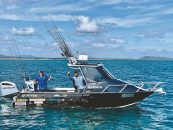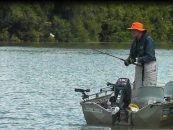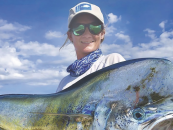Flathead is a very popular fish to catch in Australia.
KEVIN BALLANTINE and NIC WELCH offer very practical advice for catching the favourite fish in Gold Coast waters.
THE RIGHT CONDITIONS
The most productive areas for flathead are usually in close proximity to some form of weed bank. This may be an extensive shallow bank only accessible at high tide or just a single small outcrop on the edge of a small gutter. The flathead will position themselves in areas where the composition of the mud/sand bottom is extremely fertile, nutrient-rich, and provides the perfect environment for juvenile prawns, crab and baitfish to hide and grow quickly.
Large flathead can reside in deep water next to structures such as bridge pylons, wrecks, rock bars, submerged trees and rock walls. However, most flathead are generally caught in 1-2m of water and congregate around the edges of sandbanks, weed banks, and mouths of shallow estuaries. They are also found in shallow waters, near oyster leases and mangroves.
TIDES AND TIMES
The best times to fish for flathead is during the first 3 hours following the high tide, especially in areas where a large expanse of water drains over yabby banks. The flathead will lie in schools, head first, towards the current, camouflaged on the seabed ready to ambush their unsuspecting prey.
Dawn and dusk are the best times to catch flathead. However, very large specimens can be caught during the night even at dead low tide, especially when using live bait. The best conditions for catching flathead require calm weather and less than 10 knots of breeze. Sometimes a shower of rain can trigger the fish to start feeding if it has been quiet beforehand.
TECHNIQUE AND STRATEGY
Choose an area where water drains out over a ledge or through a narrow channel. Anchor downstream of this point and flick your bait or lure upstream. Let your bait drift down with the current or slowly retrieve your lure in the direction of the current.
If you have an electric motor and a pair of polarised sunglasses, flathead can sometimes be caught by sight. Flathead can be spooked if your boat gets too close, so cast well upstream of the fish and let the bait or lure travel to the fish.
Keep moving and trying different locations to avoid wasting time casting where there are no fish. Try working an area for ten minutes and if it is quiet, then move on. Remembering the same location might produce later in the day when the water height and clarity have changed.
Be careful of the spines on the corner of the jaw of the flathead and the dorsal fin. These spines are venomous and will inflict half an hour of pain to the unlucky recipient. Always use a rag or a pair of pliers when removing hooks.
If using bait, flathead have a tendency to mouth/suck the bait instead of swallowing the hook straight up, so let the flathead run for a couple more metres before setting the hook. Use a landing net as flathead have a tendency to throw the hook right next to the boat. If fishing from shore, drag the flathead up onto the beach instead of raising your rod next to the water edge.
Dusky flathead are a common catch in the Southport Broadwater and have a minimum size limit of 40 cm and a maximum size limit of 75 cm, with a bag limit of five (regardless of flathead species). The bigger flathead are the female breeders and should always be released unharmed. The smaller flathead are the tastiest to eat, so there is no point keeping the larger ones. If we all release the large ones, there will be a sustainable fishery well into the future for generations to come.
Along the break walls of the Southport Seaway
Along the western side of Wavebreak Island
Around Carter’s Bank, 100metres north of Wavebreak Island
Around Crab Island
Around Brown Island
The Aldershots
Mouth of the northern arm of Coomera River
Mouth of the Pimpama River
“The Junction” at Coombabah Creek and southern arm of Coomera River
The entrance to Bullock Head and Wasp creeks along northern arm of Coomera River
Around the Never Fail Islands
Five Ways and Tiger Mullet Channel
The mouth of the inlet at the northern end of South Stradbroke Island
Kalinga Bank
Just outside the entrance to Swan Bay on the southern end of North Stradbroke Island (NB. Swan Bay itself is a marine park and all fishing is prohibited inside)
Published in print July-September 2023






























